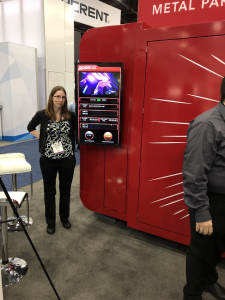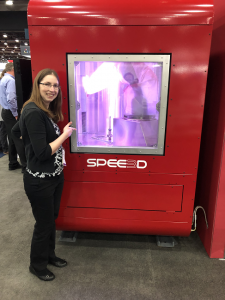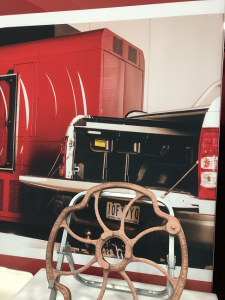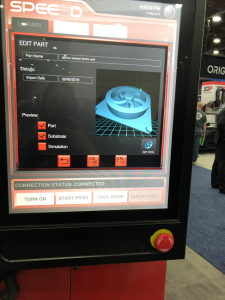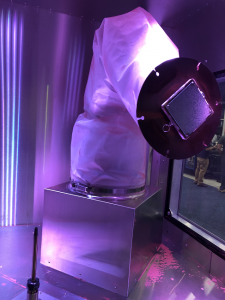At last year’s RAPID + TCT, we spoke with Australian startup SPEE3D about its patented supersonic 3D deposition (SP3D) technology and award-wining, large-format LightSPEE3D 3D printer, which is capable of 3D printing metals at production speeds. So it seemed only fitting to go back this year during RAPID 2019 and get an update on how things are going from CEO and Co-Founder Byron Kennedy.
SPEE3D, which is headquartered in Melbourne, wants to make manufacturing easier for customers, and its SP3D technology certainly seems to be doing the trick, as it allows for much faster, more cost-effective and scalable fabrication. Kennedy told me that the startup had just appointed Bruce Colter as its Vice President of US Operations, and then we talked a little about its inaugural Supersonic 3D Printing Design Challenge, which actually launched at RAPID.
The challenge description reads, “Can you dream up an object, part or artwork perfectly suited to being printed in metal? Then show off your design skills and build your portfolio by taking part in SPEE3D’s global Supersonic 3D Printing Design Challenge!”
Kennedy explained that SPEE3D is looking for “the best part that participants can design,” in two months, using its process. Then the winning entries will be printed on its large-format systems as proof of concept parts. Registration began at the show in Detroit, and has been extended through July 31st. Entrants must submit either a CAD file or engineering drawing of the part, in addition to a short description of its intended application.
For the purposes of the competition, SPEE3D has divided the 3D printing community into two different sectors: General Industry (consultants, contract manufacturers, OEMs, and service providers) and Universities/R&D (not-for-profit institutions of higher learning). The top three entrants in each category will receive a free metal print of their design, an SP3D design and SPEE3D training certificate, and free access to SPEE3D’s simulator software for six months. The winner in each category will get a GPD Pocket 2 Amber Black Micro PC.
Then Kennedy and I moved on to discussing the startup’s impressive hardware. Believe it or not, the LightSPEE3D 3D printer, with its six-axis KUKA robotic arm, is actually the smaller of its two systems (see pictures above, with me for scale). The large machine was continuously 3D printing copper parts throughout RAPID, but the most impressive copper print on display at the booth was not created on the LightSPEED.
 In April, SPEE3D announced that at RAPID, it would be displaying for the first time in public a 3D printed pure copper rocket nozzle, which was fabricated on its new 3D printer – the WarpSPEE3D, capable of producing parts up to 1 x 0.7 m using its 265 mm high nozzle. Unfortunately this new machine was not on display at RAPID, but its little brother was there, which offers a maximum part weight of 4 kg.
In April, SPEE3D announced that at RAPID, it would be displaying for the first time in public a 3D printed pure copper rocket nozzle, which was fabricated on its new 3D printer – the WarpSPEE3D, capable of producing parts up to 1 x 0.7 m using its 265 mm high nozzle. Unfortunately this new machine was not on display at RAPID, but its little brother was there, which offers a maximum part weight of 4 kg.
“The difference between the two machines is actually quite minimal,” Kennedy told me. “It’s just a bigger robot…everything else remains the same, the nozzles and the heaters, everything else is the same.”
The rocket nozzle weighs an astonishing 20 kg, stands 265 x 300 mm high, and only took about 7.5 hours to print.
“Now, as a comparison, I know that NASA just released rocket nozzles slightly smaller, but let’s call it the same, and it took them 28 days to print. So really, that’s the big difference,” Kennedy said. “Being able to print one of these and have a look at it and say right, I’m happy or I’m not, and I’ll build the next one the next day if I’m not happy with it.”
For the aerospace industry, this kind of print is that phrase we all love to say: a game-changer. This majorly reduces the lead time, which also saves on costs and makes it far easier to fix a mistake if one occurs.
“Building these large parts is very, very simple for us. In traditional metal printing, large parts are hard. With ours, it’s just all done on the end of a robot arm, so the robot does all the work for us, it’s a very simple process,” Kennedy said.
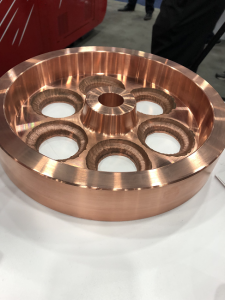 Just like with LightSPEED, the WarpSPEED prints with both copper and aluminum, and both have a maximum deposition rate of 100 g per minute, in addition to a touchscreen. Kennedy showed me another large part that had been printed on the new WarpSPEED – a 25 kg wheel for a steam engine, which took about 8 hours to print out of pure copper.
Just like with LightSPEED, the WarpSPEED prints with both copper and aluminum, and both have a maximum deposition rate of 100 g per minute, in addition to a touchscreen. Kennedy showed me another large part that had been printed on the new WarpSPEED – a 25 kg wheel for a steam engine, which took about 8 hours to print out of pure copper.
SPEE3D is really focusing on these two machines for the time being, with the LightSPEED likely to be used more for materials development and research in the future and the WarpSPEED used for industry purposes.
“You can do multiple parts on that,” he said. “You can have a plate that’s big and build multiple parts, or you can build very big parts, it makes no real difference to us.”
The first WarpSPEED was recently shipped to FIT AG in Germany, with engineers from the company planning to travel there after RAPID for its commissioning; Kennedy said a second machine has also been ordered by another customer already.
“Really that’s our focus now, selling the hardware, it’s very solid, been in the market for about 12 months now, it’s been selling well, and we’ve had reliability, ” Kennedy continued. “The reality is when you release a product, you can have some bugs in the first year and some issues, but it’s been pretty good. So we’re very happy about that.”
We moved on to the new material that SPEE3D is developing. The startup works mainly with aluminum and copper, and just recently brought in bronze as well, which is used often in the marine industry to build things like valves.
“We do have a real interest in the marine industry, because our 6061 aluminum is a very corrosion-resistant material, as well as the bronze,” Kennedy said. “So it’s an under-serviced market at the moment, because not many people can do bronze, and big parts like this is really, really difficult. You need the right materials and the right sizes for that market, and really that’s work we’re putting a lot of focus into.”
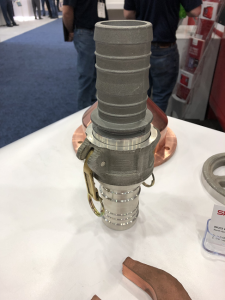 Kennedy also showed me a hose fitting that SPEE3D completed for the Australian Navy – one part is cast, and the other part is 3D printed, both out of aluminum.
Kennedy also showed me a hose fitting that SPEE3D completed for the Australian Navy – one part is cast, and the other part is 3D printed, both out of aluminum.
“These parts corrode out very quickly in the boats. What they find is they may not have this hose fitting, and they’ll have to ship it in from somewhere, and it might take them three days or a week. And during that time, they can’t take their boats out,” he explained. “This took about an hour to print, and then you machine it, so the next day you could have this ready to go.”
The part already been certified by the Navy, and tested as well.
“So the focus for us is really about standard parts and low cost,” Kennedy said. “We’re not about sophistication. You know, there’s plenty of other people over there [at RAPID] that will do super sophisticated parts. But this is the sort of thing we’re doing – pulleys and couplings…hose fittings. You’d never 3D print that normally, because it would be too expensive. Typically we quote about $100 a kilogram for the part, so you know, that [hose fitting] might be 200 grams or something, and at $100 a kilo, that would be $20. So normally 3D printing is somewhere between $1,000-$5,00 a kilogram. So that’s why you’d never 3D print it – it’s just cheaper to go and machine it.”
I mentioned that this was a typical issue one hears about 3D printing, that it’s not cost-effective, but Kennedy stated that “with this process, it is.”
Stay tuned for more from my recent trip to RAPID 2019, and take a look at some more pictures from the SPEE3D booth below:
Discuss this story and other 3D printing topics at 3DPrintBoard.com or share your thoughts in the Facebook comments below.
Subscribe to Our Email Newsletter
Stay up-to-date on all the latest news from the 3D printing industry and receive information and offers from third party vendors.
You May Also Like
Gorilla Sports GE’s First 3D Printed Titanium Cast
How do you help a gorilla with a broken arm? Sounds like the start of a bad joke a zookeeper might tell, but it’s an actual dilemma recently faced by...
Nylon 3D Printed Parts Made More Functional with Coatings & Colors
Parts 3D printed from polyamide (PA, Nylon) 12 using powder bed fusion (PBF) are a mainstay in the additive manufacturing (AM) industry. While post-finishing processes have improved the porosity of...
$25M to Back Sintavia’s Largest Expansion of Metal 3D Printing Capacity Since 2019
Sintavia, the digital manufacturing company specializing in mission-critical parts for strategic sectors, announced a $25 million investment to increase its production capacity, the largest expansion to its operations since 2019....
Velo3D Initiates Public Offering in a Bid to Strengthen Financial Foundations and Drive Future Growth
Velo3D (NYSE: VLD) has been among a number of publicly traded 3D printing firms that have attempted to weather the current macroeconomic climate. After posting a challenging financial report for 2023,...



